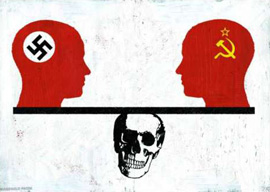
March 27, 2012

Although Snyder tells us that Stalin and his henchmen murdered lots of people, his depiction of Germans and Russians is very different. Unlike the victimized Russians under Stalin, the Germans are always at work”as they are in Daniel Goldhagen’s Hitler’s Willing Executioners“murdering and torturing Jews and Slavs. Even the German resistance in 1944 is condemned as a crew of Nazi mass murderers who decided to jump ship. This conclusion is reached on the basis of treating two peripheral figures as typical of this ill-fated resistance force, which included at its center such tried and true anti-Nazis as Leipzig Mayor Carl Goerdeler and longtime Prussian aristocratic opponents of Hitler’s regime.
A learned friend, Alfred de Zayas, has published several books on the treatment of ethnic Germans after the war. The most useful is “50 Theses on the Expulsion of the Germans from Central and Eastern Europe 1944-1948,” which is excerpted HERE. Zayas relies on German Federal Archives investigations from 1959 into the 1970s which show that between 1944 and the early 1950s over two million Germans lost their lives during brutal expulsions from Eastern Europe. This figure must be considered in the context of the “population transfer,” which the Western Allies approved at the postwar gathering in Potsdam.
Snyder describes these expulsions as a generally workmanlike removal of populations from one spot to another and pretends that the massacres of German populations in Czechoslovakia, Yugoslavia, and elsewhere in Eastern Europe never occurred. After an asterisk, we learn that…
…of the 12 million Germans who fled or were expelled from Eastern Europe at the end of the War, the vast majority came from Czechoslovakia or Poland….[A]bout half of the twelve million fled, and about half were deported”though a neat division is impossible, since some of those who fled later returned and were then deported.
He makes no mention of the multiple murders that accompanied the forced deportations.
These expulsions and organized killings were not, as Snyder suggests, merely justified reactions to German war crimes. Czech, Polish, and other interwar East Central European governments, as Zayas explains, had well-publicized plans to expel their large German minorities. WWII’s aftermath served as a pretext for nationalists and pro-Soviet forces throughout Eastern Europe to carry out ethnic cleansing on a grand scale. As Zayas points out, both the UN and the Catholic Church fully accept his figures for German deaths and expulsions, numbers which are clearly unacceptable to Snyder and the New York Review of Books.
German historians and researchers now routinely lowball the figures for German deaths from wartime firebombing and later expulsions. Since the 1970s the deaths that resulted from the bombing of Hamburg, Dresden, and other then-defenseless German and Austrian cities seem to have fallen steadily. The impression created is that only neo-fascists could believe these supposedly justified bombings had devastating effects. Casualty figures are lowered by insisting that only a precise counting of “geborgenen Leichen (intact corpses)” can be accepted in determining who died where. Noticing the disappearance of people from this planet will not do. Nor will it suffice that someone testified that he saw his family or neighbors killed. Such people were obviously self-pitying Nazi war criminals.
If such fastidious criteria were applied to tallying Jewish victims of Nazi persecution, the researcher would be jailed in Europe or Canada as a Holocaust denier. But since no one at The New York Times, Weekly Standard, or any other establishment-press fixture complains about massacred Germans”and since most Germans don”t give a rap about atrocities against their ancestors”it is unlikely Zayas’s scholarship will attract much attention.